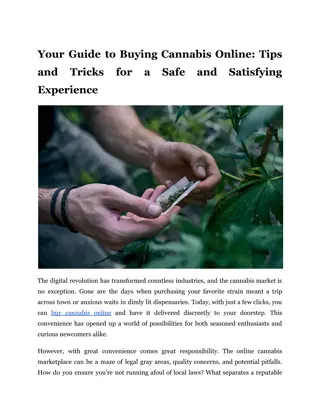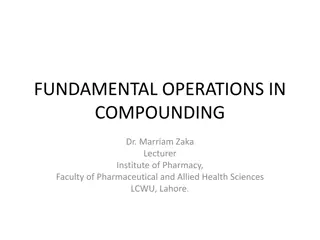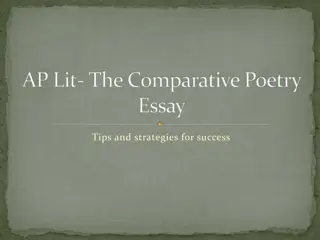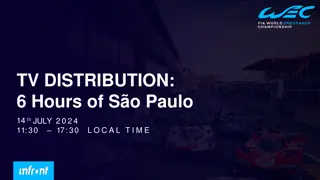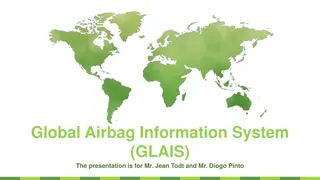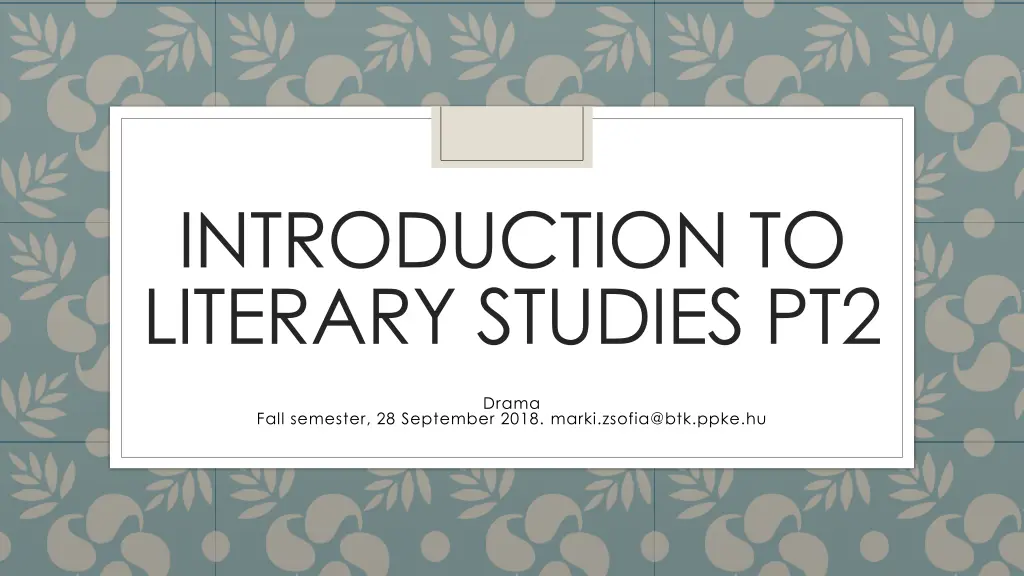
Understanding Drama in Literary Studies
Explore the origins, forms, and evolution of drama in literary studies, from ancient Greek performances to Renaissance popular culture. Delve into the significance of different stages in interpreting dramatic texts and the dynamic nature of drama texts. Uncover the birth of Renaissance drama from medieval roots, and the secularization of themes in Early-Modern English drama.
Download Presentation

Please find below an Image/Link to download the presentation.
The content on the website is provided AS IS for your information and personal use only. It may not be sold, licensed, or shared on other websites without obtaining consent from the author. If you encounter any issues during the download, it is possible that the publisher has removed the file from their server.
You are allowed to download the files provided on this website for personal or commercial use, subject to the condition that they are used lawfully. All files are the property of their respective owners.
The content on the website is provided AS IS for your information and personal use only. It may not be sold, licensed, or shared on other websites without obtaining consent from the author.
E N D
Presentation Transcript
INTRODUCTION TO LITERARY STUDIES PT2 Drama Fall semester, 28 September 2018. marki.zsofia@btk.ppke.hu
Introduction to Reading Drama Origins: rituals, games of make-belief, imitative action. Later fertility plays, where Spring was battling Winter, then conflicts of people and the supernatural. Dramas were written for the live performances. Greek drama social and cultural event. Renaissance drama popular culture. From 17thcentury drama slowly becomes high culture, huge theatre buildings appear. The main modes of drama: tragedy, comedy, romance, satire, tragicomedy Specific identifiable form: dialogue, stage directions, names, author-narrator not visible Odd example: http://members.efn.org/~dredmond/Hamletmachine.PDF Performance studies: one text many performances (in modern times) Before printing: many versions existed of one play Drama text vs performance text drama studies vs performance studies
Introduction to Reading Drama What kind of stage was the play written for? When we read a drama, for the understanding of the possible worlds represented in the text it is often indispensable to know the kind of theatre and the kind of representational logic of the stage for which the text was intended. Horizon of expectations: if you don know the circumstances, you might have a different interpretation, or even not see hidden meanings in a play. In each era drama was presented in different ways: different shapes of theatres, attitudes, women played by men, masks, high culture or popular culture theatres, religious or secular topics etc. Stages were always changing according to to historical-cultural context
Drama text Information gap: we don t know anything aside the dialog, have to fill in the gaps Special attribute of the dramatic text is that it uses words to create action through the dialogue of characters in a situation which is just happening. The dramatic text always concentrates on the here and now of an action, it intensifies the referentiality of the text, and for this purpose it uses a special capacity of language called deixis. Deictic language draws the attention to the here and now of the speech act (here, there, now, look, see, etc.) (Kiss A, Matuska ., 227) The text as an always changing entity: each published print of the same LWA can be different even today. Text is not as stable as we think. Shakespeare s Hamlet has three known versions: Q1, Q2, F1. Q1 called the bad Quarto, probably a transcript by an actor, who worked based on memory
Birth of the Renaissance Drama Other names: Early-Modern English Drama, Elizabethan Drama Developed from Medieval dramas morality plays, nativity plays, liturgical dramas Allegorical events and characters: Everyman (cc 1490): e.g Mankind (1475), Psychomachia fight of opposing spiritual forces (evil and good) 1500s interludes: small allegories played out in ballrooms of the aristocracy Secularization of drama: non-religious themes.
Humanist Movement and Theatre The influence of classical (ie. Greek and Roman) drama and philosophy. School reform: classical dramas become part of the curriculum Comedy: influence of Plautus and Terrence Tragedy: influence of Seneca (Tenne Tragedies 1581) drama is rhetorical in character : the birth of monologues. Horror, passion become part, but only told and not shown (as in classical dramas) Inns of Court: Cambridge, Oxford. Schools where upper-class men trained to be lawyers. Students and teachers copied classical plays, and rewrote them. First playwrights: Ben Johnson, Thomas Kyd, Christopher Marlow
The Stage as Microcosm Medieval iconography of the micro and macrocosm. Stage is a representation of the world. Balcony: heavens Trap door door to hell Shape of theatres round. Public theatres: Rose, Fortune, Swan, Globe Almost 3000 spectators could fit in Outskirts of the town, popular, secular, socially heterogenous, cheap Further reading: Fabiny, Tibor (Ed.). Shakespeare and the Emblem. Studies in Renaissance Iconography and Iconology. Szeged, 1984.
Hamlet on Elizabethan stage Hamlet myth had been around for decades (myth of Amleth) So called Ur-Hamlet, the first stage version commonly associated to Thomas Kyd Reading Hamlet with Early-Modern stage in mind. Looking at scenes differently: ghost scene, graveyard scene - Hamlets in hell. Play within a play: microcosm within the microcosm meta drama. Get thee to a nunnery nunnery as a brothel.
Hamlet in Purgatory Though in drama there is only text, and no one speaker, not all characters are equally reliable. Hamlet in Purgatory Stephen Greenblatt Hamlet s indecisiveness his knowledge of the murder comes from the Ghost In Elizabethan times ghosts generally thought of as evil characters, not reliable Old Hamlet is in purgatory this is where ghosts come from All young Hamlet is looking for, is real proof. Read the scene, compare adaptations. Russian Hamlet Ghost scene: https://youtu.be/5XWbGN0zmlw?t=1248 Reduced Shakespeare Company Ghost Scene: https://youtu.be/BvPdWcCHkxM?t=126
Hamlet and Women Female characters in Shakespeare s time: played by men on stage, usually few lines. Hamlet has very bad opinion about women: Frailty thy name is woman! (Act I, Scene 2) Get thee to a nunnery scene (Act III, Scene 1) Bedroom scene with Gertrude (Act III, Scene 4) Ophelia feminist reading: mirror of Hamlet without patriarchal power. Gertrude Why does she drink poison in the las scene?
Myths and Hamlet Hamlet as Electra: revenge of the murder of the father the good king. Usurper: Claudius. Hamlet s Oedipus complex Killing of the Divine King: (James G. Frazer, The Golden Bough) if the king becomes corrupted, sick, ill or old, he must be killed. In this sense the king represents the country. If the king is sick the country is sick. King Hamlet was murdered the new king is a murderer Hamlet goes mad he is the heir to the throne, but by killing his uncle, he himself becomes corrupted.
Shakespeare, Hamlet, Canon Is Hamlet, Prince of Denmark the greatest English play of all time? Is William Shakespeare the greatest English playwright? Canon (Greek: measuring rod, standard) The process of canonization: originally referring to canonization of scripture in the Bible Western literary canon Folger Shakespeare Library https://www.folger.edu/ - sources for research (bibliographies, stage versions, primary texts, etc) Perpetual re-telling of stories: Hamlet, and its many adaptations How to perform something that has become a clich ? https://youtu.be/N5C3VavvSUo?t=645
Adaptation, and its theories First literary adaptations to film started with the creation of cinema Adaptation of Shakespeare s King John, 1899. Shakespeare has 410 screen adaptations Not only screen adaptations: Heiner M ller: Hamletmachine, 1977 Tom Stoppard: Rosencrantz and Guildenstern are Dead, 1966. Shakespeare s plays had rewritten versions with different endings in the Restoration (18th century) Theory of adaptation first only concentrated on literary adaptations to screen Brian McFarlane: Novel to Film, 1996.
Adaptation, and its theories Later theorists expanded it to every possibility: novel to film, film to novel, film to film, drama to novel, novel to video games and so on. Linda Hutcheon: A Theory of Adaptation is the most expansive an thorough description so far. Defines adaptations as: 1. Formal entity or product: transposition of a work that can involve a shift of medium 2. Process of creation: it involves re-interpretation and re-creation, appropriation, salvaging 3. Process of reception: it is a form of intertextuality it is engaged with the adapted work
Rosencrantz and Guildenstern are Dead No! I am not Prince Hamlet, nor was meant to be; Am an attendant lord, one that will do To swell a progress, start a scene or two, Advise the prince; no doubt, an easy tool, Deferential, glad to be of use, Politic, cautious, and meticulous; (T. S. Eliot's The Love Song of J. Alfred Prufrock, 1917) Two insignificant characters from Hamlet become main characters The last words of the play become the title Two characters ultimately looking for their role. Is it a tragedy or a comedy? Can you understand the play without knowing Hamlet? Does the play give any commentaries on Shakespeare s play? Does knowing Hamlet change your perception of the play?
Rosencrantz and Guildenstern are Dead Existential questions: All your life you live so close to truth, it becomes a permanent blur in the corner of your eye, and when something nudges it into outline it is like being ambushed by a grotesque. What questions do they bring up during the play? How do they think of death? Do they have free choice or was everything determined? They don t seem to remember anything before they were on the road. Are they even real people? The play is looking at what the characters do behind the scene, when they are not on stage (not the actors)
Plays within plays within plays Mise-en-abyme The perpetual repetition of watching and being watched Perpetual repetition of death Perpetual repetition of coin tossing Repetition of questions Audience watches R and G watching the play within a play scene Does this mean that everything repeats itself?
Stoppard and his time Stoppard is perhaps best characterised as a post-modernist writer, someone who self- consciously interrogates and reflects upon the fragments of the culture he has inherited. (Robert Gordon, 1991) Post-war dramas: Tradition of characters that are not heroes Typically in Beckett s plays (Waiting for Godot, especially Endgame) Characters waiting for their doom to come Did they ever had a choice? GUIL: Our names shouted in a certain dawn ... a message ... a summons... there must have been a moment, at the beginning, where we could have said-no. But somehow we missed it.
Gertrude Talks Back Margaret Atwood, Canadian contemporary author Most of her work deals with complex, ambiguous women, questioning of classical female roles, oppression (The Handmaid s Tale, Alias Grace, The Blind Assassin) Gertrude Talks Back rewriting canonical portrayal of women Published in a short story collection Good Bones (O. W. Toad, 1992) Based on Shakespeare s play: what do we know of Gertrude? Does Atwood s approach change the bedroom scene between Hamlet and Gertrude? Can we still talk about Oedipus-complex?
Gertrude Talks Back The character of Hamlets mother has posed problems of interpretation to readers, critics and performers, past and present, and has been variously or simultaneously appraised as a symbol of female wantonness, the object of Hamlets Oedipus complex, and an example of female submissiveness to the male principle (Hamlets as much as Claudius). Like other revisionist rewritings produced by women writers in the last few decades, Margaret Atwood s short story challenges received concepts of the female, and particularly the Frailty, thy name is woman notion that has marked so much canonical literature. Based on Shakespeare s Hamlet, do we know if Gertrude took part in the murder of the King? By admitting the murder, what changes?
Two adaptations What is the similarity between the two adaptations? How do they approach the original text and the original plot? Do they change the plot of the Shakespearean play? Do they add anything to the intertext of the play? Intertextuality: a concept that assumes an interrelationship between texts. These can be similar texts, quotes, allusions, adaptations, parody, translations etc. Hutcheon: the intertextual cloud of a certain work contains the adaptations and the original text as well. They should be treated equally.






